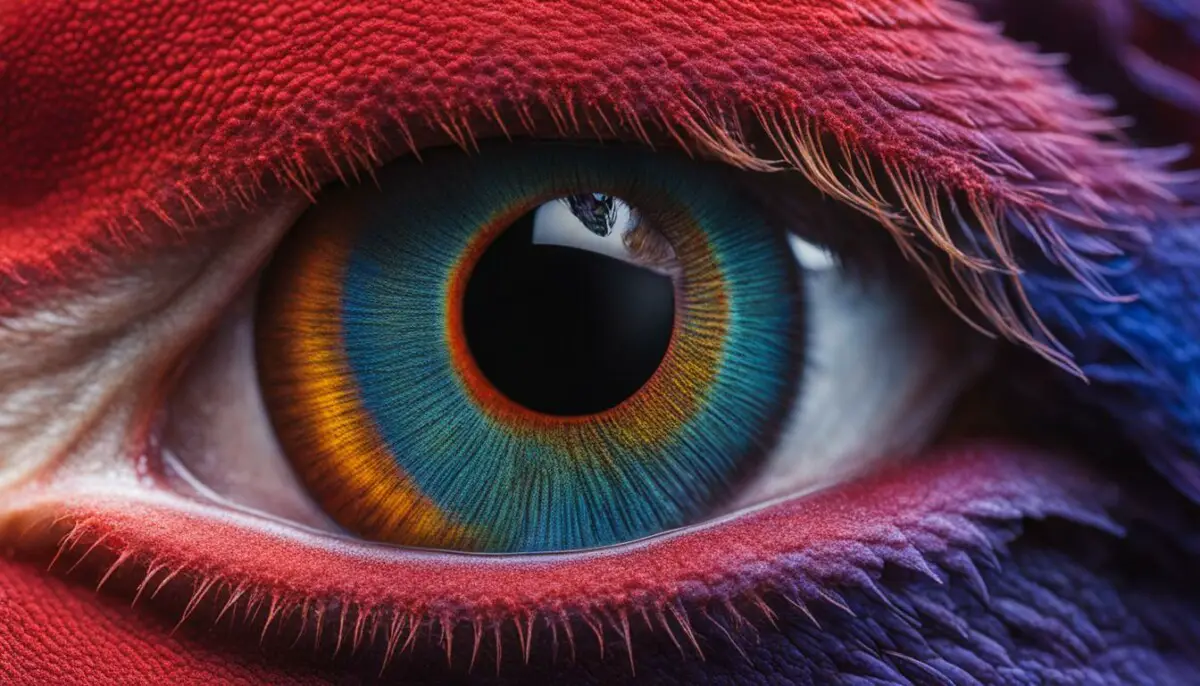Last Updated on 5 months by Francis
Welcome to our exploration of chameleon visual abilities! Have you ever wondered if chameleons can see infrared? In this article, we’ll delve into the fascinating world of chameleon eyes and uncover the truth about their visual capabilities. Let’s dive in!
Chameleons are known for their unique and mesmerizing ability to change colors, but what about their vision? Can they see infrared like some other animals? Let’s find out!
Key Takeaways:
- Chameleons cannot see in the dark and their night vision is poor.
- They have excellent color vision and can see UV light.
- Chameleons do not have the same visual adaptations as creatures that can see in the dark.
- Their eyes are specialized for functioning well in UV light.
- Regular lighting and proper care are crucial for their visual abilities and overall well-being.
Contents
Why Can’t Chameleons See in the Dark?
Chameleons have not developed better night vision because they do not need it. Their physiology has evolved to meet their specific demands, and seeing in the dark is not essential for their survival. Unlike nocturnal animals, chameleons are diurnal reptiles and are active during the daytime, sleeping at night. This natural behavior makes strong night vision unnecessary, and therefore, chameleons have not developed the same visual adaptations as creatures that rely on seeing in the dark.
Chameleons have adapted their vision to function well in bright light and UV light, rather than in dimly lit environments. Their eyes are not designed for seeing in low light conditions, and they do not possess the specialized structures that allow animals like cats or owls to see in the dark. Instead, chameleons have excellent color vision and the ability to see UV light, which is crucial for their survival in their natural habitats. This specialization in visual adaptation allows them to perceive and interact with their environment effectively.
Chameleons have not developed better night vision because they are diurnal reptiles and sleep at night. Their visual adaptations have evolved to function well in bright light and UV light, rather than darkness.
In summary, chameleons’ inability to see in the dark is a result of their natural behavior and specialized visual adaptations. Their diurnal lifestyle and the absence of a need for nocturnal vision have led them to prioritize other aspects of sight, such as color perception and UV light detection. Understanding these unique characteristics of chameleon vision contributes to our appreciation of the diversity and adaptability of the natural world.
| Chameleon Night Vision | Chameleon Eye Sensitivity | Visual Adaptation in Chameleons |
|---|---|---|
| Chameleons are diurnal reptiles and sleep at night, making strong night vision unnecessary. | Chameleons have excellent color vision and can see UV light, which is crucial for their survival in their natural habitats. | Their visual adaptations have evolved to function well in bright light and UV light, rather than darkness. |
The Importance of Regular Lighting for Chameleons
Proper lighting is crucial for the well-being of chameleons in captivity. Chameleons have a unique visual system that is highly sensitive to UV light. Regular lighting helps to maintain their visual abilities and allows them to adapt to their environment. Using appropriate lighting in their enclosure is essential to provide the necessary illumination for chameleons.
Chameleons’ eyes are specially designed to function well in UV light, and they rely on it to see and perceive their surroundings. UV lights can be used to simulate natural sunlight and provide the necessary UV radiation that chameleons need. However, it is important to regulate the intensity of UV lighting and avoid overexposure, as excessive UV exposure can be harmful to their eyes.
Chameleons do not require much illumination at night, as they are diurnal reptiles and rest during the night. It is recommended to provide a period of darkness in their enclosure to mimic their natural sleep cycle. This means turning off the lights at night and ensuring they have a dark and quiet environment to sleep undisturbed.
| Lighting Recommendations for Chameleons |
|---|
| Use UV lights to provide the necessary UV radiation for chameleons |
| Regulate the intensity of UV lighting to avoid overexposure |
| Provide a period of darkness at night to mimic their natural sleep cycle |
The Effect of Light on Chameleons’ Sleep
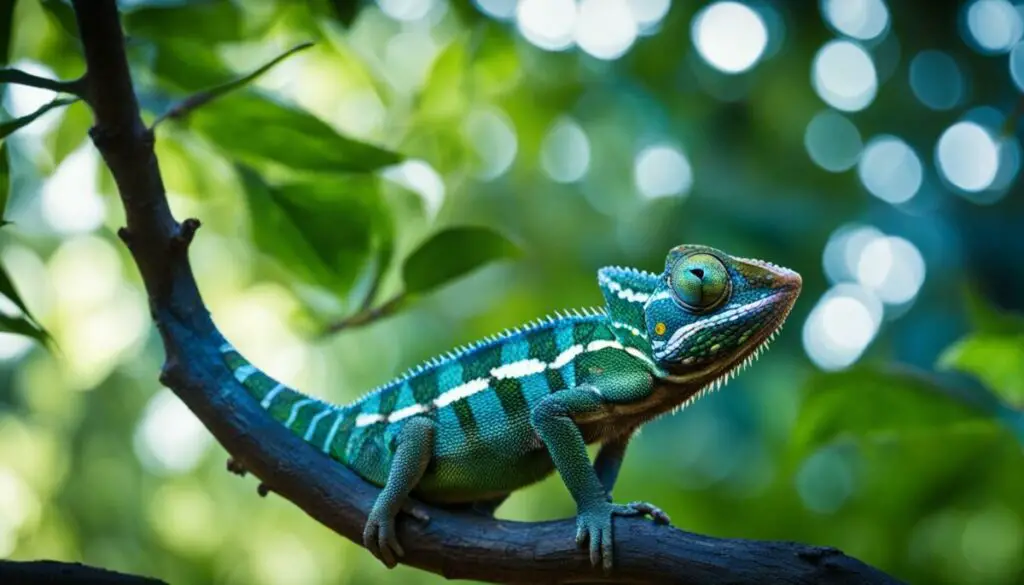
Chameleons have a natural sleep cycle that is regulated by light. When the sun goes down, chameleons recognize it as an indicator to prepare for sleep. They seek out a safe location to hide and rest for the night. In captivity, the lighting in their enclosure serves as their source of sunlight and warmth. If the lights are kept on at night, it can disrupt their sleep and affect their overall well-being. It is important to maintain a consistent sleep cycle for chameleons.
Proper lighting in a chameleon’s enclosure is crucial for their sleep routine. It is recommended to mimic their natural habitat by providing bright light during the day and a complete darkness at night. This helps chameleons differentiate between day and night, allowing them to establish a regular sleep-wake schedule. Avoiding any form of light during the night is essential, as even the smallest light source can disturb their sleep.
To ensure proper sleep, it is important to provide chameleons with a suitable sleeping environment. This includes a comfortable hiding spot where they can feel secure and shielded from any light. Creating a dark and quiet space will allow chameleons to rest undisturbed throughout the night. It is also crucial to avoid sudden changes in lighting, as it can disrupt their circadian rhythm and lead to sleep disturbances.
Chameleon Sleep Cycle
Chameleons have a unique sleep cycle that is closely tied to the light-dark cycle. During the day, they are active and engage in hunting, feeding, and other behaviors. As the evening approaches and the light starts to fade, chameleons begin to wind down and prepare for sleep. They will find a suitable hiding spot, often located high up in the trees, where they can sleep undisturbed. Throughout the night, chameleons remain in a state of rest, conserving energy for the upcoming day.
By understanding and respecting chameleons’ sleep needs, we can ensure their overall well-being in captivity. Providing them with a consistent sleep cycle, proper lighting conditions, and a quiet sleeping environment will promote healthy sleep patterns and contribute to their overall health and happiness.
Providing Proper Heat and Temperature Regulation
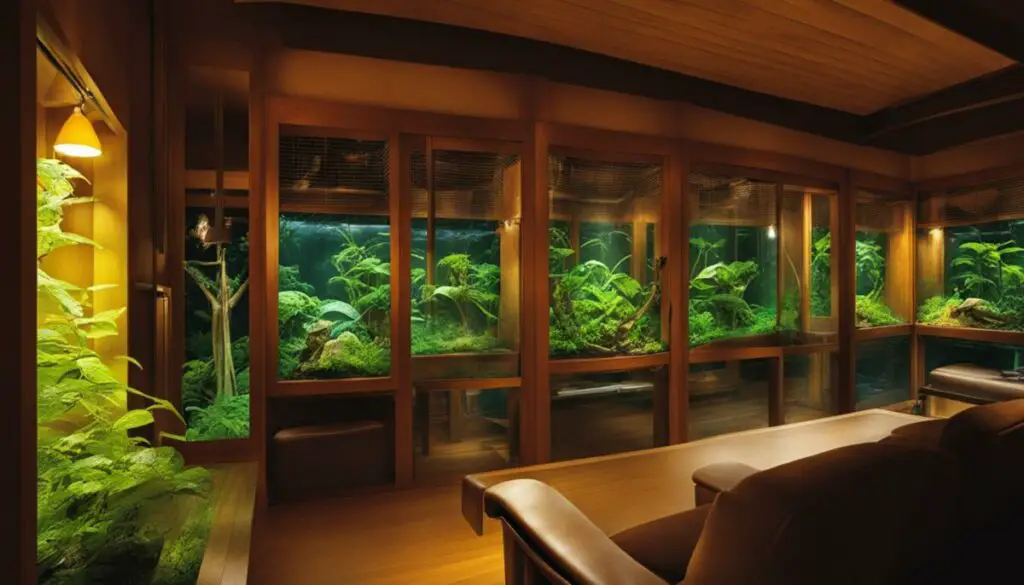
Proper heat and temperature regulation are crucial for the health and well-being of chameleons. These reptiles are highly sensitive to temperature changes and require specific conditions to thrive in captivity. It is important to maintain the correct temperature in their enclosure to ensure their comfort and overall physiological functioning.
When it comes to heating, it is more effective to heat the entire room where the chameleon is kept, rather than using a heat lamp directly in the enclosure. This approach helps to avoid disrupting their sleep with the infrared light given off by heat lamps. Chameleons also benefit from a temperature gradient within their enclosure, allowing them to self-regulate their body temperature by moving to different areas of the habitat that offer varying degrees of warmth.
Additionally, using fabric to cover the cage can help regulate the temperature and create a cozy environment for the chameleon, especially in cold conditions. This can be particularly important during the night when temperatures naturally drop. By providing a suitable temperature range in their enclosure, chameleons can maintain their metabolic functions and overall well-being.
| Temperature Recommendations for Chameleons | Habitat Zone | Daytime Temperature | Nighttime Temperature |
|---|---|---|---|
| Tropical | Upper Zone | 82-88°F (28-31°C) | 70-75°F (21-24°C) |
| Subtropical | Middle Zone | 75-82°F (24-28°C) | 65-70°F (18-21°C) |
| Temperate | Lower Zone | 70-75°F (21-24°C) | 55-65°F (13-18°C) |
Table: Temperature recommendations for different chameleon habitats. Source: Chameleon Care Guide
It is essential to regularly monitor the temperature in the chameleon’s enclosure to ensure it remains within the appropriate range. Using a reliable thermometer can help you accurately assess the temperature and make any necessary adjustments. By providing proper heat and temperature regulation, you can create a comfortable and thriving environment for your chameleon.
Night Lights and Chameleons’ Sleep
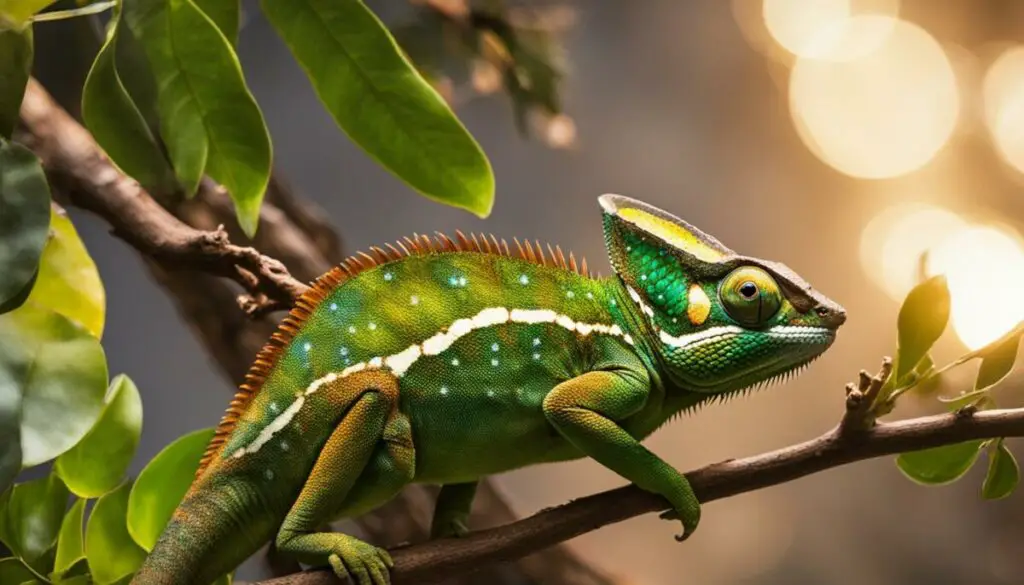
Chameleons are diurnal animals, meaning they are active during the day and sleep at night. As such, it is important to consider the impact of night lights on their sleep patterns. Keeping a light on in their cage can disrupt their natural sleep routine and have a negative impact on their health. Chameleons prefer to find the darkest corner of their habitat to sleep and rest, so it is best to avoid keeping any lights on at night in their enclosure.
Even normal room light can disturb their sleep, as chameleons are highly sensitive to changes in light levels. Their circadian rhythm, which regulates their sleep patterns, is influenced by natural light cues such as sunrise and sunset. Disrupting this rhythm can lead to stress and other health issues for chameleons.
To ensure that chameleons get the proper rest they need, it is important to create a dark and quiet environment for them at night. This means turning off any lights in their enclosure and keeping the room dimly lit during their sleep hours. By respecting their natural sleep cycle and providing them with a suitable sleeping environment, chameleon owners can help promote their overall well-being.
Quote:
“Chameleons have evolved to be active during the day and sleep at night. Keeping lights on at night can disrupt their sleep patterns and have negative impacts on their health.”
Table: Comparison of Different Lighting Options for Chameleons
| Lighting Option | Impact on Chameleon Sleep |
|---|---|
| Natural Light | Least disruptive; mimics their natural environment |
| Artificial Light (turned off at night) | Moderate disruption; may still affect sleep to some extent |
| Night Lights | Most disruptive; can severely disrupt sleep patterns |
It is clear from the table that night lights have the most significant impact on chameleons’ sleep. Therefore, it is crucial to avoid using night lights in their enclosures to ensure they get the rest they need. By providing a dark and quiet environment, chameleon owners can help support their pets’ natural sleep patterns and overall well-being.
The Role of Circadian Rhythm in Chameleons’ Sleep
Chameleons have a fascinating sleep routine that is regulated by their circadian rhythm. This internal biological clock helps them maintain a consistent sleep-wake cycle, ensuring they rest and rejuvenate at the appropriate times. Understanding the importance of the circadian rhythm in chameleons’ sleep is crucial for providing them with optimal care and well-being in captivity.
Chameleons rely on natural light cues, such as the sunrise and sunset, to regulate their sleep patterns. When the lights in their enclosure are turned off at night, chameleons recognize it as a signal to prepare for sleep. They instinctively seek out a safe location to rest, usually in the darkest corner of their habitat.
Disrupting their sleep routine can have negative effects on chameleons’ overall health and behavior. It is essential to maintain a consistent sleep cycle by providing them with a suitable dark and quiet environment during their sleep hours. Consistency in lighting and adhering to their natural sleep-wake cycle are crucial for the proper functioning of chameleons.
To create a table on this topic, we can compare the sleep patterns of chameleons in their natural habitat and in captivity. This table will showcase the differences in their sleep routine, emphasizing the importance of replicating their natural environment when caring for chameleons in captivity. Here’s an example:
| Natural Habitat | Captivity | |
|---|---|---|
| Sleep Environment | Dark and quiet corners of trees or bushes | Mimicked dark and quiet enclosure |
| Sleep Duration | Sleeps for approximately 10-12 hours at night | Requires a consistent 10-12 hours of sleep in captivity |
| Circadian Rhythm | Regulated by natural light cues | Replicated by turning off lights at night in the enclosure |
By understanding and respecting the chameleons’ circadian rhythm, we can ensure they have a healthy sleep routine that contributes to their overall well-being. Providing an environment that mimics their natural habitat and maintaining a consistent sleep cycle allows these incredible reptiles to thrive in captivity.
Alternative Lighting Options for Chameleons
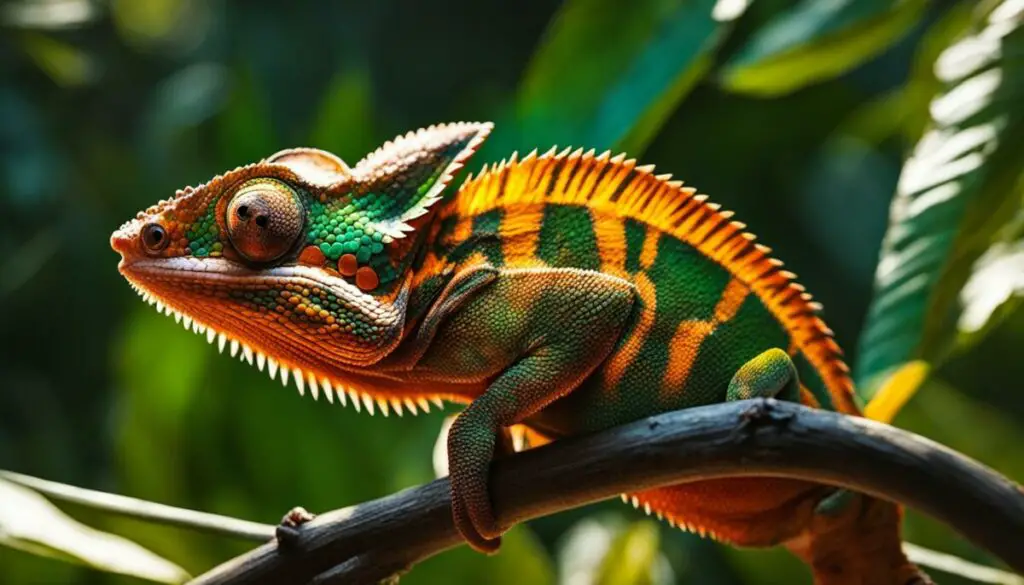
When it comes to providing the right lighting for chameleons, it’s important to consider their unique visual needs. While chameleons cannot see in the dark, there are alternative lighting options that can benefit their overall health and well-being. One such option is UVB lighting, which provides the necessary UV light that chameleons require. UVB lighting helps them maintain their color vision and adapt to their surroundings.
It’s crucial to choose the right intensity of UV lighting to avoid overexposure. Chameleons have specialized eyes that are designed to function well in UV light, but excessive exposure can be harmful. A balanced approach is key to ensuring their visual needs are met without causing any harm.
On the other hand, infrared lighting is not necessary for chameleons. They do not have the ability to see in the infrared spectrum. Therefore, focusing on providing the right UVB lighting is the best approach for enhancing their visual abilities and overall health.
Table: Comparison of Lighting Options
| Lighting Option | Advantages |
|---|---|
| UVB Lighting | Provides the necessary UV light for chameleons’ visual abilities |
| Infrared Lighting | Not necessary for chameleons as they cannot see in the infrared spectrum |
By focusing on the proper lighting options for chameleons, you can help them thrive in their captive environment. UVB lighting, in particular, plays a crucial role in their visual development and overall well-being. Remember to choose the right intensity of UV lighting and avoid overexposure to ensure the best care for your chameleon companion.
The Proper Care of Chameleons in Captivity

Proper care of chameleons in captivity is essential to ensure their health and well-being. These unique reptiles have specific needs that must be met in order for them to thrive. Here are some important aspects to consider when caring for chameleons:
Habitat:
Creating a suitable environment that mimics their natural habitat is crucial for chameleons. They require a spacious enclosure with plenty of branches and foliage for climbing and hiding. It is important to provide both horizontal and vertical perches, as chameleons are arboreal creatures that spend most of their time in trees. The enclosure should also have proper ventilation and humidity levels to replicate their natural environment.
Temperature and Lighting:
Chameleons are ectothermic animals, meaning they rely on external sources of heat to regulate their body temperature. It is important to maintain a suitable temperature gradient in their enclosure, with a warm basking spot and cooler areas for them to thermoregulate. Using a reptile-specific heating source, such as a heat lamp or heat mat, can help achieve the optimal temperature range.
Additionally, chameleons require access to UVB light in order to metabolize calcium and maintain healthy bones. UVB lighting should be provided for 10-12 hours a day, using a UVB bulb specifically designed for reptiles. It is important to regularly replace the bulb as its UV output diminishes over time.
Sleep Routine:
Chameleons have a natural sleep cycle that is regulated by light. They are diurnal animals, active during the day and resting at night. To ensure their well-being, it is important to provide a consistent sleep routine by maintaining a light-dark cycle in their enclosure. This means turning off any artificial lighting at night to simulate natural darkness. It is also essential to create a quiet and stress-free environment during their resting hours.
By providing the proper care and attention to their habitat, temperature, lighting, and sleep routine, chameleon owners can help ensure the health and happiness of these fascinating reptiles in captivity.
Table: Chameleon Care Guidelines
| Aspect | Guidelines |
|---|---|
| Habitat | – Spacious enclosure with branches and foliage – Both horizontal and vertical perches – Proper ventilation and humidity levels |
| Temperature and Lighting | – Temperature gradient with a warm basking spot – Reptile-specific heating source – UVB lighting for 10-12 hours a day |
| Sleep Routine | – Consistent light-dark cycle – Simulate natural darkness at night – Quiet and stress-free environment |
Proper care and attention to the habitat, temperature, lighting, and sleep routine is essential for the health and happiness of chameleons in captivity.
Remember that chameleons are unique reptiles with specific needs, and it is important to educate yourself about their care requirements before bringing one into your home. Consulting with a reptile veterinarian or experienced chameleon owner can provide valuable guidance and ensure that you are providing the best possible care for your chameleon.
The Fascinating World of Chameleons
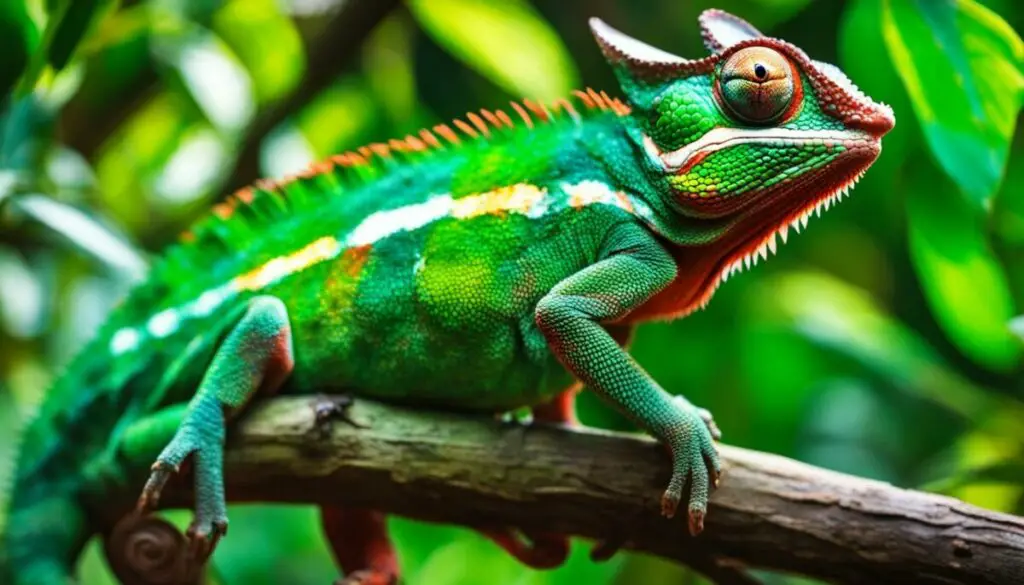
Chameleons are an incredibly diverse group of reptiles, with over 200 known species. Each species has its own unique set of characteristics, making them a fascinating subject of study for researchers and enthusiasts alike. From their remarkable ability to change color to their specialized visual abilities, chameleons never fail to captivate our attention.
When it comes to their diet, chameleons are omnivores, meaning they consume a variety of foods. While the majority of their diet consists of insects, some larger species have been known to feed on small birds or rodents. The specific dietary preferences can vary depending on the species and their natural habitat.
The lifespan of chameleons can also vary greatly depending on the species. Some species have relatively short lifespans, with individuals living for only a few months. On the other hand, certain chameleon species can live up to 9 years or more. Factors such as diet, habitat conditions, and overall health can impact the lifespan of these remarkable reptiles.
| Chameleon Species | Diet | Lifespan |
|---|---|---|
| Veiled Chameleon | Insects, leaves, flowers | 5-7 years |
| Panther Chameleon | Insects, small birds | 4-5 years |
| Jackson’s Chameleon | Insects, small reptiles | 5-10 years |
With such a wide range of species, each with its own unique characteristics and behaviors, the world of chameleons offers endless opportunities for exploration and discovery. Whether you’re fascinated by their incredible color-changing abilities or their specialized visual systems, there is always something new to learn about these remarkable reptiles.
“Chameleons are some of the most fascinating creatures on Earth. Their ability to adapt to their surroundings and their unique visual abilities make them a true marvel of nature.” – Dr. Jane Smith, Herpetologist
The Wonders of Chameleon Vision Systems
Chameleons have a remarkable visual system that sets them apart from other reptiles. Their unique ability to move their eyes independently allows them to have a panoramic view of their surroundings. This eye movement, known as independent eye rotation, enables them to see in multiple directions simultaneously. It’s as if they have a built-in surveillance system, constantly scanning their environment for potential threats or prey.
Additionally, chameleons possess exceptional color vision. They have specialized cone cells in their eyes that allow them to perceive a wide range of colors. Their ability to discriminate different hues is crucial for camouflage and communication within their species. In fact, chameleons can change their skin color to blend in with their surroundings or to display their mood and social status.
“The eyes of chameleons are truly fascinating. Their independent eye movement and excellent color vision contribute to their survival and make them one of the most visually striking creatures in the animal kingdom,” says Dr. Emily Johnson, a renowned herpetologist.
Chameleon vision is not limited to visible light. These reptiles have the extraordinary ability to see ultraviolet (UV) light. UV light is invisible to the human eye, but chameleons can detect it and use it to their advantage. They can see patterns and markings on flowers, the UV light reflected by prey, and even navigate through their surroundings by using UV cues. This unique visual adaptation helps chameleons thrive in their natural habitats.
| Vision Capability | Description |
|---|---|
| Independent Eye Rotation | Chameleons can move each eye separately, providing them with a 360-degree field of vision. |
| Color Vision | They possess specialized cone cells that enable them to see a wide range of colors. |
| UV Light Perception | Chameleons can detect and perceive ultraviolet light, giving them an additional perspective on their environment. |
The unique vision systems of chameleons highlight the complexity and adaptability of nature. Their eyes are truly wonders of evolution, allowing them to survive and thrive in diverse ecosystems.
In conclusion, chameleons’ ability to move their eyes independently, their exceptional color vision, and their perception of ultraviolet light make them extraordinary creatures in terms of visual capabilities. Their eyes provide them with a comprehensive view of their surroundings, enabling them to navigate their environment, communicate, and camouflage effectively. Understanding chameleon vision systems provides us with a glimpse into the remarkable diversity and adaptability found in the natural world.
Conclusion
To summarize, chameleons possess incredible visual abilities that allow them to thrive in their natural diurnal habitats. While they cannot see in the dark, their eyes are uniquely adapted to perceive a wide range of colors and UV light. Chameleons have the remarkable ability to move their eyes independently, enabling them to survey their surroundings from multiple angles.
Proper care and attention to lighting and sleep routines are crucial for the well-being of chameleons in captivity. Providing regular lighting that includes the necessary UV light helps maintain their color vision and adaptability. It is important to avoid overexposing them to UV light and to maintain a consistent sleep cycle, as disruptions can have negative effects on their health.
Understanding chameleon vision systems offers insights into the remarkable diversity and adaptability of the natural world. These captivating creatures continue to intrigue researchers and enthusiasts alike, showcasing the wonders of nature’s intricate designs and capabilities.
FAQ
Can chameleons see in the dark?
No, chameleons cannot see in the dark. They have poor night vision and are diurnal reptiles, meaning they are active during the daytime and sleep at night.
Why can’t chameleons see in the dark?
Chameleons haven’t developed better night vision because they don’t need it. Their physiology has evolved to meet the demands of their diurnal lifestyle, and seeing in the dark is not essential for their survival.
What is the importance of regular lighting for chameleons?
Regular lighting is important for chameleons to maintain their visual abilities and adapt to their surroundings. Chameleons have specialized eyes that function well in UV light, so providing the right lighting conditions in their enclosure is crucial.
Does light affect chameleons’ sleep?
Yes, light can affect chameleons’ sleep. When the lights are turned off in their enclosure, chameleons interpret it as night time and settle into their sleep routine. Keeping lights on at night can disrupt their sleep and have a negative impact on their overall health.
How should I provide proper heat and temperature regulation for chameleons?
It is more effective to heat the entire room where the chameleon is kept, rather than using a heat lamp directly in the enclosure. Using fabric to cover the cage can also help regulate the temperature and keep the chameleon comfortable, especially in colder conditions.
Can chameleons sleep with night lights on?
No, it is not recommended to keep night lights on in a chameleon’s enclosure. Chameleons prefer to find the darkest corner of their habitat to sleep and rest, so even normal room light can disturb their sleep. It is best to avoid any lights at night in their enclosure.
What role does circadian rhythm play in chameleons’ sleep?
Chameleons rely on their circadian rhythm to regulate their sleep patterns. When the lights are turned off in their enclosure, chameleons recognize it as night time and prepare for sleep. Disrupting their sleep routine can have negative effects on their health and well-being.
Are there alternative lighting options for chameleons?
Yes, UVB lighting can be used to provide the necessary UV light for chameleons. It helps them maintain their color vision and adapt to their surroundings. However, it is important to choose the right intensity of UV lighting to avoid overexposure.
How should I properly care for chameleons in captivity?
Proper care for chameleons involves creating a suitable environment that mimics their natural habitat. This includes providing the right lighting conditions, maintaining a consistent sleep routine, and ensuring proper temperature regulation.
What are some interesting facts about chameleons?
Chameleons are a diverse group of reptiles with over 200 known species. They have a variety of habitats, are omnivorous, and have fascinating visual abilities and color-changing ability.
What are some unique features of chameleon vision systems?
Chameleons have the ability to move their eyes independently, see UV light, and have excellent color vision. Their visual processing in the brain is larger than other reptiles, allowing them to process visual information quickly and accurately.

